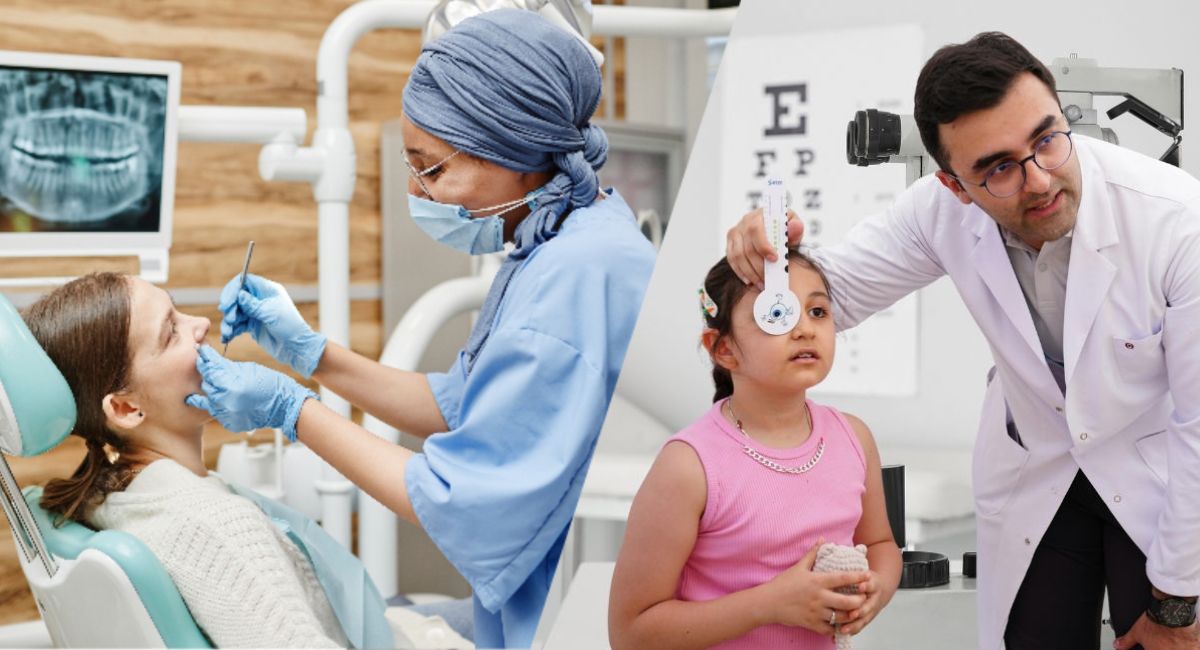At an ACOM briefing with ethnic media, experts expose the critical Medi-Cal vision and dental services slipping through the cracks—and what it means for California’s diverse communities.
Eye exams, glasses, and dental checkups—all free under Medi-Cal. So why aren’t millions using them? A new ACOM briefing brings answers and action.
Only one in five eligible Californians uses their Medi-Cal vision or dental benefits, despite having access to free, comprehensive care.
This was the focus of a recent community media briefing hosted by American Community Media (ACOM), moderated by Research Director Selen Ozturk, as part of an ongoing series in partnership with the Department of Health Care Services (DHCS). The conversation tackled what’s available, who qualifies, and why so few are taking advantage.
Dr. Donnie Hsu, Chief of the Medi-Cal Vision Program, spoke first. With the calm authority of a seasoned optometrist and public servant, he laid out a stark truth: “Vision care is a gateway to whole-person health.”
Under Medi-Cal, eligible individuals can receive comprehensive eye exams, prescription glasses—including bifocals—and even specialized lenses or artificial eyes, all at no cost. And yet, many don’t know. Only a fraction of the 15 million Medi-Cal enrollees access these benefits annually.
Dr. Hsu offered both an explanation and a warning. “People assume if their vision seems fine, they don’t need care. But so many chronic conditions—diabetes, hypertension, even neurological issues—can first be spotted in a routine eye exam.”
And the impact of untreated vision issues? Lost workdays. Unsafe driving. Missed medications. Social withdrawal. Hsu called this “a public health failure we can no longer afford.”
He also emphasized equity. After a decade-long cut, California restored adult vision benefits. Now, any Medi-Cal enrollee—from infants to centenarians—can access services. This includes enhanced care management for those with complex needs, like diabetic retinopathy, who may also require help with nutrition, housing, and follow-ups.
Just as sobering was the insight from Dana Durham, Chief of the Medi-Cal Dental Program. “You qualify for Medi-Cal; you qualify for Medi-Cal Dental,” she said plainly. “But many don’t know it—and time is running out for some.”
Durham pointed to July 1, 2026, when a looming policy change will strip full dental benefits from certain undocumented adults and those with limited immigration statuses. “We’re talking about thousands of people losing access to checkups, cleanings, dentures, and more. After 2026, they’ll only qualify for emergency dental care.”
For now, though, the program is robust: checkups, x-rays, fillings, root canals, braces for qualifying kids, and even gum disease treatment. Preventive services like fluoride varnish, sealants, and education are all part of the push toward CalAIM—the state’s transformation of Medi-Cal into a system that prioritizes prevention and whole-person care.
“Dental care is not cosmetic,” Durham stressed. “It’s critical. Tooth decay leads to infection. Gum disease is linked to heart problems. Poor oral health can signal diabetes. It affects school performance, employability, and confidence.”
That last point echoed powerfully in the voice of Eileen Espejo, Senior Managing Director of Health at Children Now. With years of advocacy under her belt, she delivered a heartfelt plea: “No child should suffer through toothaches or blurry vision in silence. These are not small inconveniences. They affect how children eat, sleep, learn, and even smile.”
Espejo painted a vivid picture—kids embarrassed to laugh, missing school from dental pain, and unable to focus due to eye strain. Her team works to integrate health services directly into schools, but the barriers remain steep.
Cultural stigma. Language gaps. Fear of costs. Misinformation. Apathy born of exhaustion.
That’s why, she said, the role of ethnic media is indispensable. “You are trusted messengers,” she told journalists. “You speak the language—not just linguistically, but culturally. If families hear it from you, they’re more likely to believe it.”
Throughout the briefing, speakers returned to one phrase: use your benefits.
The Medi-Cal lens factory, for example, produces unbreakable lenses for kids. If glasses are lost or broken? Replacements are free. Many eye exams require no referral. Care coordination and community health workers are available to help families navigate.
On the dental side, new tools like the “Find a Dentist” app and fee-for-service options across most of California simplify access. No plan required. No cost to eligible members.
But usage remains low.
A million glasses dispensed is a powerful image—but with 15 million eligible, it’s not enough.
Durham put it bluntly: “A Medi-Cal member should never be paying for dental care. If they are, something’s wrong.”
Even so, trust must be rebuilt. Too many adults remember when benefits were denied. Others never knew they existed. Still more feel ashamed to ask—or fear the care won’t be good.
The call to action was clear. Speak up. Educate. Empower. Bring services out of obscurity and into everyday knowledge.
Because, as Hsu reminded, “We are all part of the healthcare team.”
#MediCalMatters #ImmigrantHealth #DentalEquity #VisionCare #CalAIM #HealthAccess #EthnicMedia #CommunityCare #FreeHealthServices #StayCovered


